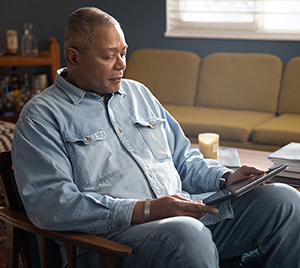Having a Video Medical Visit (Telehealth)
Many healthcare providers now offer video and phone visits. This is also known as telehealth or telemedicine. This can help you manage your health if you have a chronic condition like diabetes, heart disease, or COPD. Or you may have an injury or illness and need a consultation. Or you may need mental health counseling. Many of these things can be done with telehealth.
Healthcare from home
You don’t have to go into a provider’s office, clinic, or hospital. Instead, you can have a healthcare appointment from your own home. During a video visit, you can see and talk to your provider in real time. You do this on your computer, tablet, or phone. Your provider may offer short phone calls to check in on you. You may be able to send and receive messages through an online patient portal.

When to use telehealth
Telehealth is a good option for:
-
Managing a chronic condition that’s under control, like diabetes
-
Mild symptoms of an illness, such as a rash
-
A minor injury
-
Questions about medicines you’re taking
-
Questions about ongoing treatment
-
Involving family members in your care to help with shared decision making and follow up
When to go in for a visit
Telehealth isn’t for an emergency. It may not be best for serious problems. You may need to have an in-person visit if you have any of these:
And you should go to the emergency room if you have any of these:
How is telehealth done?
You can do a telehealth visit from your computer. Or you may use your smartphone. Your healthcare provider’s office may use a video tool on a website or an app.
They will give you information on how to use the telehealth tool. Follow their instructions.
Privacy priorities
Your health information is protected by law. This is part of the rules of the Health Insurance Portability and Accountability Act (HIPAA). Your healthcare provider will take care to make sure your privacy is protected. If you have concerns, ask questions before your telehealth visit.
Getting ready for your video visit
Before your visit:
-
Write down your list of questions and issues to go over with your provider.
-
Download the video application your provider’s office uses. Follow all instructions they give you for how to install and set it up. You may need to use a certain web browser. You may need to download an app. If you’re not comfortable with tech, ask a family member or friend to help you set up the video app.
-
Plan to do your video visit in a quiet, private place. Turn on lights so your healthcare provider can see you well.
-
Limit distractions as much as possible.
-
Make sure your video camera is steady and working well. Your provider will want to see you clearly.
-
Be ready to take notes. Have a pad and pen handy.
-
Test your device at least 20 minutes before the video visit to make sure it’s working.
-
Have your phone nearby. This is in case the video doesn’t work and they need to call you.
During your video visit
Start the video visit on time following the provider’s instructions. Tell your provider what you want to address during your visit. Take notes if you can. But you can also ask if they can email you an after-visit summary.
During your telehealth visit, you can show your provider:
-
Swelling, bruising, or injuries
-
Where your headache hurts
-
A rash or other skin problem
-
Where on your body you’re having pain or other issues
Your provider may ask you to send photos of an injury, rash, or other problem if it’s hard to see on video.
Insurance check
Before you schedule a video visit, make sure your health insurance will cover it. Ask the provider’s office to request preauthorization. This means they contact your insurer directly to find out. Medicare covers video, phone, and messaging telehealth visits.